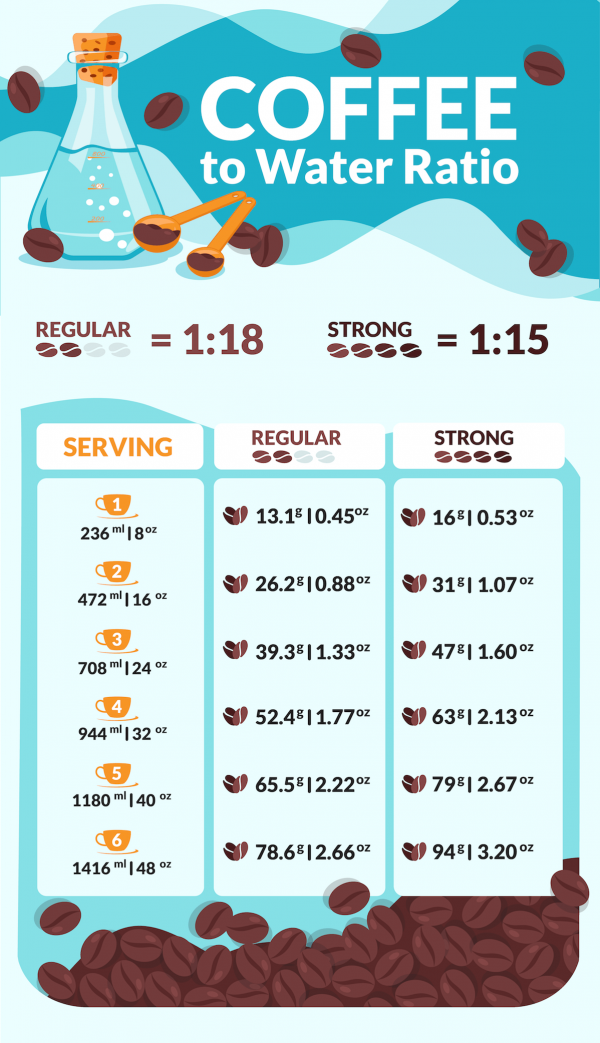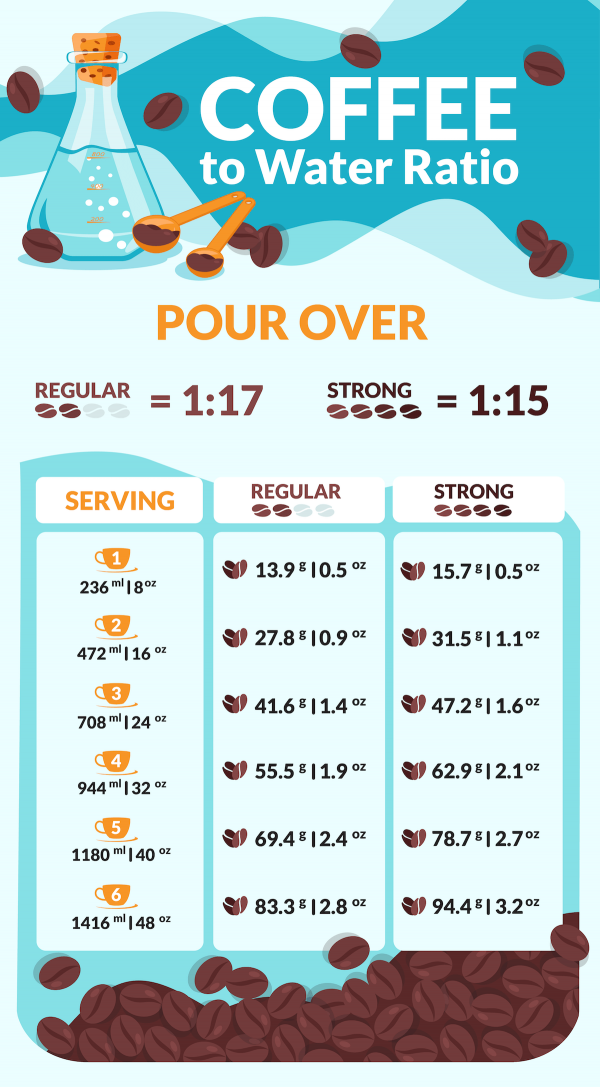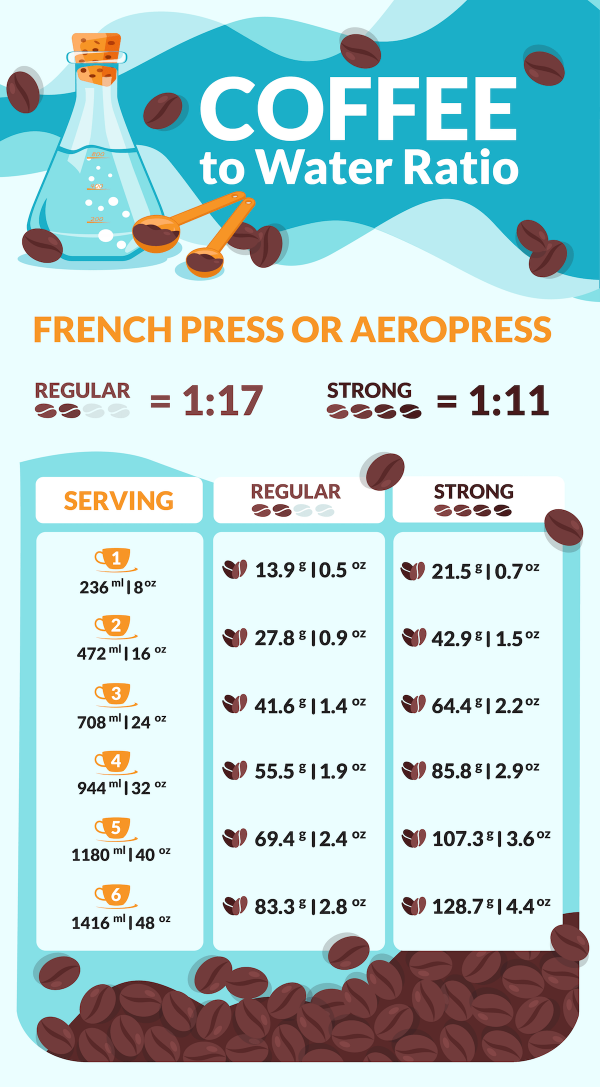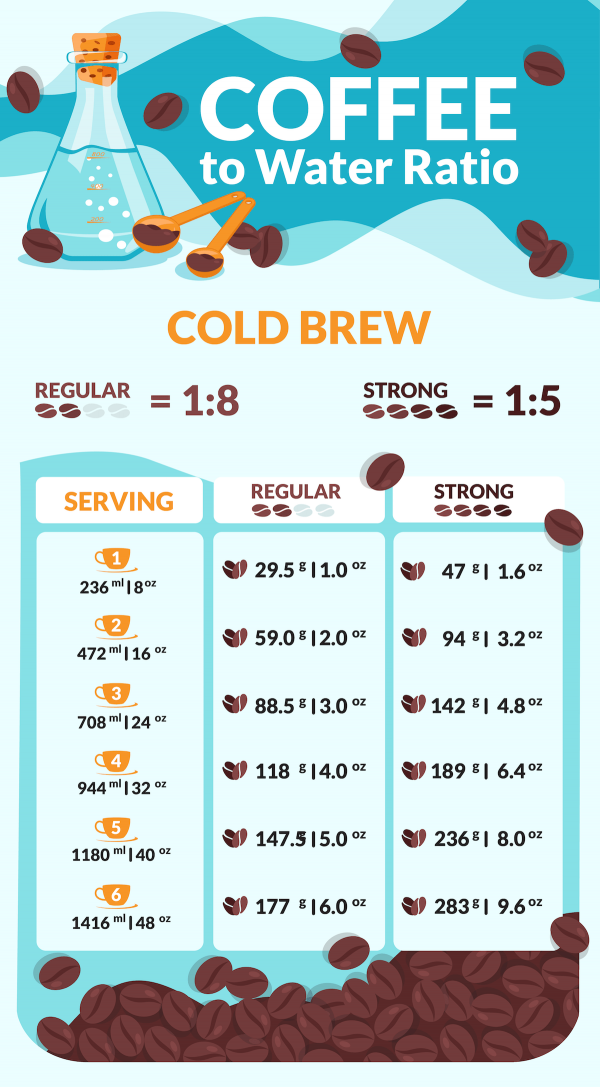Coffee to Water Ratio: Make the Perfect Cup with these Charts
You’ve got fresh, quality coffee, a decent grinder and a good brewing setup, but you’re just not satisfied with the results.
What could be wrong? While there are lots of possibilities, one of the best places to start is by looking at your coffee to water ratio.

Instead of wasting time fiddling with settings, you can put just a little effort into find the right water to coffee ratio for you. With this solid foundation in place, you can then continue experimenting with your brewing process.
Brew Ratio Calculator
If you want to skip the math and dizzying charts altogether (and who doesn’t?), a simple calculator can help you determine how many grams of coffee you need for your desired volume and brew strength for a particular brewing method.
Try out the calculator below for a starting point. Then experiment to find out the ideal water to coffee ratio for your tastes.
Water
Choose the amount of water in milliliters:
Brewing Method:
Choose the strength:
What Is the Best Brew Ratio for Coffee?
Some people talk about a Golden Ratio, an ideal number that makes the perfect cup of coffee. While that would make everything easier, it is also a little too simplistic. There isn’t a perfect ratio for every cup, every brew method, every person.
But that doesn’t mean we have to be totally in the dark.
General

For most brewing methods and tastes, you can start with a ratio of between 1:15 and 1:18. The first should give you a strong, full-flavored coffee. The second will be lighter.
I recommend experimenting, trying different ratios side-by-side to determine your preferences for different roasts and brewing methods.
In general, though, you probably don’t want to go stronger than 1:12 for most methods because the results will just be too muddy. And getting lower than 1:20 or so is going to leave you with watery, bland coffee that is likely too bitter.
Drip or Pour Over

Drip coffee is the most common type for many coffee drinkers. Also called infusion brewing, this is the method you get with auto-drip machines as well as manual pour-over brewers like the Chemex.
It is an efficient way to brew coffee because there is a constant supply of fresh water running through the coffee. This helps extract all of the TDS without over-saturating the grounds (which we will see below).
Because of its efficiency, drip typically requires less coffee. A ratio between 1:15 and 1:17 will get you from bold to standard.
Immersion

With immersion, the coffee is in the water (immersed) the entire time. This style covers methods like the French Press and the AeroPress.
Since the same water is in contact with the coffee, it has a tendency to saturate the grounds, preventing efficient extraction like with drip coffee. You can counter this by stirring or agitating the grounds, but you can also use more grams of coffee to ensure more flavor.
Since immersion methods are typically used for a bold cup, you can start with 1:15 for a standard cup of coffee and go as low as 1:12 for a strong brew.
Cold Brew

Yes, cold brew is also immersion. But it’s a bit different than standard methods because the water is not heated. That means we need to adjust ratio, or you’ll end up with brown water, not coffee.
Cold brew is a much less volatile process, and it takes more time. This means a greater chance of saturated grounds, so you’ll need plenty to get an acceptable flavor.
For a full-flavored cold brew, you can use a 1:5 coffee to water ratio, and for a lighter brew, 1:8. This is a case where experimenting is key, especially since brew times (and whether you brew at room temperature or in the fridge) can make a big difference.
A personal favorite is using the french press method for a cold brew. Make sure the ground coffee is not too granulated. Using a french press is a great way to get all the flavor!
Special Mention: Espresso
Again, espresso is technically an infusion brew. But it also is very different from drip coffee because of the pressure involved. It also creates an altogether different type of brew, one with much less volume and bolder flavors.
Since espresso machines can vary so much, it is difficult to really nail down a ratio. Also, you will be using the same amount of coffee for each shot. The difference comes in the length of pull. Since a shorter pull requires less water, you end up with a stronger shot (like the ristretto).
In general, a 1:1 ratio is typically considered a ristretto shot. A ratio of 1:2-3 is normal, and a 1:4 ratio is a lighter, lungo shot. That is, of course, depending on a consistent grind quality.
The Importance of Brew Ratio for Making Great Coffee
Brewing coffee is a relatively simple process, even if you get super scientific or fancy. Aside from water temperature, brew time, grind, and brew method, you don’t really have that much to control.
At its most basic, the drink is ground coffee and hot water.
Because of that simplicity, you can make a significant difference by changing the ratio of coffee to water.
Extraction
Extraction is really the magic that makes coffee possible. It’s the process of pulling the soluble compounds (like caffeine, carbohydrates, lipids, acids, and sugars) out of the coffee, which gives it the flavor we all love.
Brew ratio is important because affects how much of the good stuff is pulled out of the coffee without getting too much of the bad. (This can change with brew method and grind size as well.)
Under-extracted coffee is often sour without much sweetness. Basically, the citrus notes of the coffee are extracted first, and they are not balanced by the sweet and slightly bitter flavors that come later.
Over-extracted coffee goes too far, pulling more acidic, bitter flavors out than you want, which isn’t pleasant either.
While brew time, temperature, and grind will all affect extraction. Brew ratio does as well. Too much coffee, and you’ll likely have an under-extracted drink. Not enough, and it will be over-extracted, which isn’t good either.
Strength
First of all, strength refers to flavor more than the caffeine content.
And the flavor of coffee is largely determined by the amount of Total Dissolved Solids (TDS), which I mentioned above. The more scientific folks in the world of coffee will use a refractometer to accurately measure the number of solid particles in a brew to judge its extraction.
For most of us, though, we can tell by the taste.
For a stronger cup, with a bold flavor, you generally need more coffee. It allows for more TDS in the cup without over-extraction. If you don’t use enough coffee, the result will be thin and watery. Too much, though, and it could be overpowering and even muddy.
Brew Ratio Basics
Since there aren’t that many ingredients, many people just throw coffee and water together haphazardly and never wonder about the results. One day, the coffee is great. The next day it stinks.
But that isn’t you. You want to fine tune your process. You want to experiment with the few variables you can control. And that’s where the coffee to water ratio comes in.
Professional Baristas Use Recipes
Think of it like baking a cake. You can adjust the size of your cake by adding more flour. But that means you need to adjust the other ingredients accordingly.
Baristas who value consistency have recipes too. There are only two ingredients, so they pay close attention to them.
Some recipes will tell you how much coffee per liter or per cup. The most useful way to breakdown the ratio is by weight.
Why Use Weight for Your Brew Ratio
As we’ve discussed before, scoops are the most common way to measure coffee. But this eyeballing also isn’t reliable. A scoop can differ from person to person and roast to roast.
Instead, you’ll want to measure by weight, which means having an accurate scale.
For the best results, you should weigh your water too. This might seem weird for some folks because we tend to think of water and other liquids in terms of volume.
Fortunately, water converts easily. One milliliter of water weighs one gram. Simple. Half a liter? That’s 500 g.
And if you simply refuse to think in metric, a half-liter (500 ml or 500 g) is just over two cups (16.9 fluid ounces).
What the Numbers Mean
Don’t worry, you don’t need to be a math genius to figure out brew ratios. When expressed as numbers, you’ll typically see something like 1:12 or 1:16. In words, that’s “1 gram of coffee per 12 grams of water” and “1 gram of coffee per 16 grams of water.”
Not everyone puts coffee first, but you can always count on the larger number representing water. Just imagine putting 1 ml of water in a scoop of coffee and you can see why that is.
To figure how much coffee you need for a desired volume, just divide your goal by the larger number in the ratio. For example, if you want to brew 1 liter at a 1:16 ratio, you would divide 1000 (that’s how many grams of water you want) by 16. That would give you 62.5.
That’s 62.5 grams of coffee for 1000 grams of water, a 1 to 16 ratio. (Or you can always just use the calculator above.)
Takeaway
There’s a short list of what we can really control in life. But the quality of your coffee should be on that list. It doesn’t take that much effort to take control of your process.
By using a little bit of measurement and calculation, you can improve the consistency of your daily brew. And with a little experimentation, you might find your Golden Ratio, regardless of what type of coffee you’re in the mood for today.
Be sure to check out the calculator above, and let me know how it matches your experience.